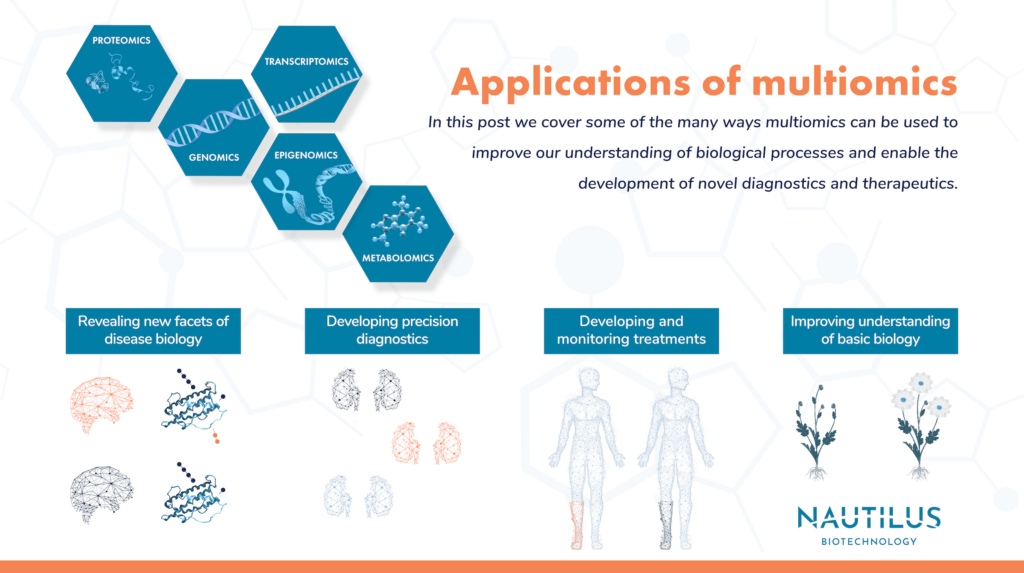
Proteomics is one of several omics disciplines that study life through the lens of key biological molecules. Other such disciplines include genomics, the study of all DNA in an organism, epigenomics, the study of heritable changes in gene expression that don’t directly stem from mutations in DNA, and metabolomics, the study of all the metabolites in an organism.
Combining various omics approaches into a multiomics perspective can yield holistic views of biological systems that reveal associations and processes previously invisible. Bringing together insights from genomics with proteomics, for example, can show which genes are turned into proteins inside a cell, as well as how those proteins are modified.
Researchers are merging omics in innovative ways to yield insights never before possible. In this blog post, we cover some exciting new applications of multiomics. With novel tools including next-generation proteomics technologies like the Nautilus Proteome Analysis Platform, the field of multiomics will only continue to grow and bear fruit.
Examples of multiomics in action
In a 2020 study in Nature Genetics, researchers used transcriptomics to identify specific genes upregulated in Alzheimer’s disease, including two that change histone proteins. Following up with a proteomic analysis of the altered histones, the researchers found they were more commonly associated with Alzheimer’s than other proteins. Epigenomic profiling then showed how these histone modifications altered disease pathways associated with Alzheimer’s, which the authors suggest could lead to strategies for early-stage treatment.
Multiomics could also make it possible to diagnose diseases easier. In a review published in 2020 in Nature Reviews Nephrology, researchers outline the potential ways multiomics could help make diagnosis of chronic kidney disease (CKD) far more precise. There are multiple types of CKD, and it can be tough to tell them apart. Combining data from genomics, transcriptomics, proteomics, and metabolomics could enable doctors to classify various presentations of CKD into more targeted groups, and make it easier to identify and deliver precision medicines.
Researchers can additionally use multiomics to study how, and to what extent, a new treatment is working. In a 2019 paper in PLOS One, researchers studied the effects of fecal microbiota transplants on rats that were overweight and whose microbiomes were disrupted by antibiotics. Fecal transplants involve taking gut microbes from healthy donors and transplanting them into patients to improve their microbiome health. In this case, the researchers combined genomics and proteomics to see not only which microbes were present after the transplant, but also what those microbes were doing. The researchers say their results showed that fecal microbiota transplants can restore normal gut function.
Excitingly, animals aren’t the only kingdom of life we can study with multiomics. Researchers have also combined omics to learn more about fruit ripening, a complex process that is still not fully understood. Studies across various omics have uncovered how genes and transcription factors contribute to tomato ripening, how dozens of proteins regulate ripening in peaches, apricots, and other fruits, and how metabolic networks change during different developmental stages in various fruits.
Advancing multiomics with new technology
Combing individual omics studies into a true multiomics perspective is beginning to deliver holistic insights into biology that could lead to better treatments for patients, enhanced knowledge of microbiome function, and more. New technologies are advancing the multiomics revolution by making each of the disciplines comprising multiomics faster, more accessible, and more comprehensive than ever before. New genetic sequencing tools make it possible to sequence a genome for just hundreds of dollars, while high-throughput RNA-Seq makes it possible to quickly analyze the transcriptome. In the field of proteomics, next-generation proteomics tools like the Nautilus Proteome Analysis Platform are designed to unlock substantively the entire proteome of nearly any sample, while making proteomic analysis faster and easier.
With the confluence of better technologies across multiple omics, the goal of a comprehensive multiomic understanding of life may soon be within reach.
Check out this episode of the Translating Proteomics podcast to learn how we can leverage multiomics to study “Biology in Space and Time”
MORE ARTICLES


